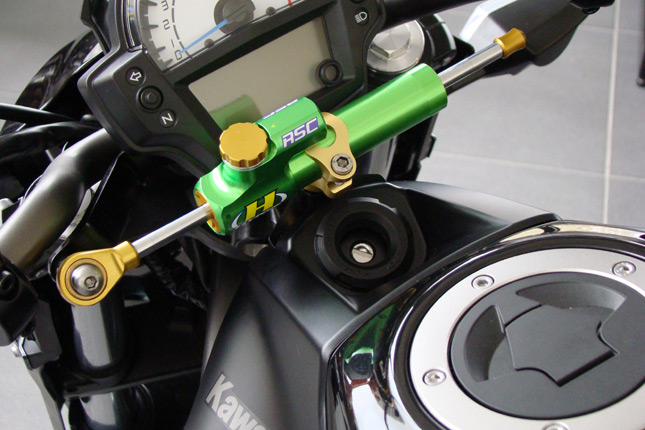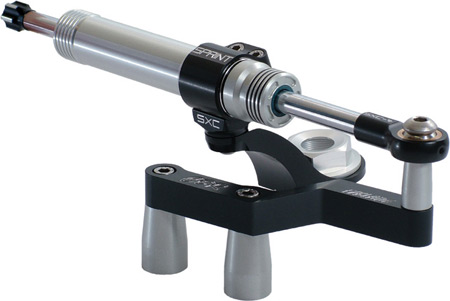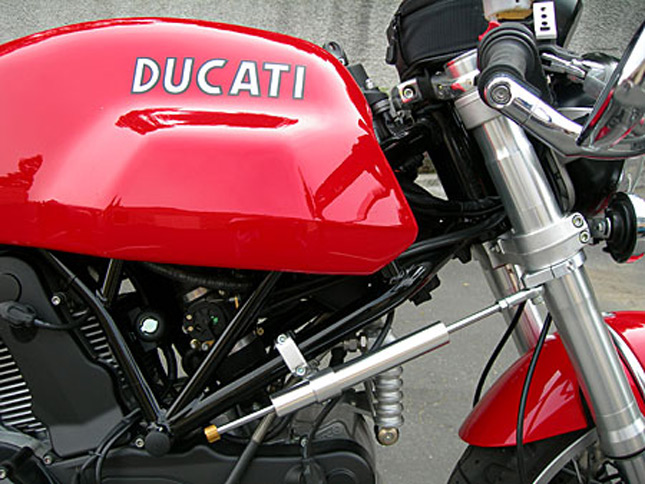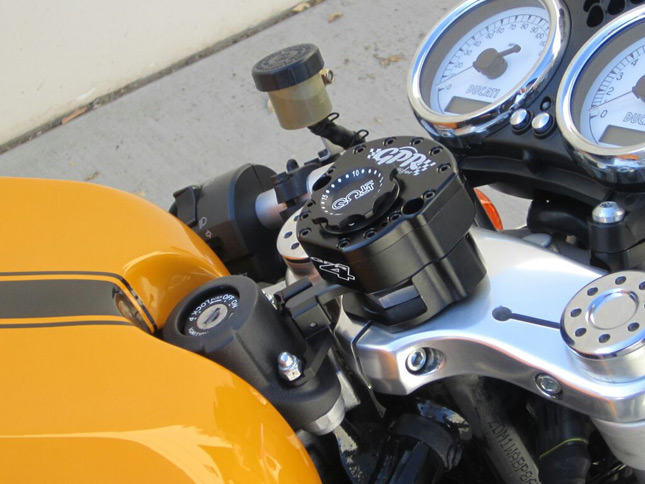Quite often you must have seen a small shock absorber kind of equipment fitted on the top of sportbikes near handlebar. Ever wonder what is that and why is it placed there? That thing is called "Steering Damper" or "Steering Stabilizer". We will tell you why steering damper is needed on motorcycles and how they work in detail.
 Steering Damper or Stabilizer:
Steering Damper or Stabilizer:
As the term suggests the equipment acts as stabilizer or damper doing stabilizing or damping to the steering of the motorcycle. For better understanding, imagine riding your motorbike at very high speed and suddenly hitting a big pothole or something like that, however the primary damping of the impact is normally taken by the front shock absorber of your bike but sometimes you experience an uncontrolled wobble at your front wheel. This wobbling in extreme conditions is called "Tank Slapper" where both the extreme ends of your handlebar gets knocked at your fuel tank. Now you can imagine how scary it can be if happened at very high speed.
In supersport bikes where the wheelbase is generally kept short and the rake angle is kept shorter too for aggressive and sharp handling of the motorcycle, specially at the corners. Such sportbikes don't need any pothole to get their front wheel wobbled, the lightweight and powerful engine of such motorbikes can easily pop-up the front wheelie and wheelies at high speed could easily cause dis-balance of the bike specially the front wheel which is airborne while the wheelie.
If the bike's front wheel lands on the ground at slightest of the deviation from the rest of the body, you can imagine what could happen at high speed. This is where the Steering Damper or Stabilizer comes handy, the job of the damper is to keep the entire front of the bike stabilized even when it is not in contact with the ground and is airborne. The steering damper do not let the motorcycle steering loose so that it could tilt on either side due to gravity. Types Of Steering Dampers:
Types Of Steering Dampers:
The motorcycle Steering Dampers are broadly categorized into two; Linear and Rotary. The linear steering dampers are more commonly used and can easily be found in the after market and can also easily be installed on any motorbike. Linear Steering Dampers:
Linear Steering Dampers:
The linear steering stabilizers are more like shock absorbers and basically they work on same principle of hydraulics. The one end of the linear Steering damper is mounted to the steering yolk or triple tree of the bike and the other with the frame. The linear Steering Damper can be installed right on the steering yolk of the bike longitudinally or it can also be fitted transversely across the frame of the bike. Rotary Steering Dampers:
Rotary Steering Dampers:
The rotary steering stabilizers are more modern and sophisticated kind of dampers mounted only on the steering column with other end fitted to the frame of the bike. The rotary steering damper is connected with the ECU of the bike from where it detects the speed of the bike and other vital info, based on those information the hydraulic fluids are pumped into the damper making the steering loose or hard depending upon the circumstances.
Advantages of Steering Dampers:
By: Farhan Kashif
 Steering Damper or Stabilizer:
Steering Damper or Stabilizer:As the term suggests the equipment acts as stabilizer or damper doing stabilizing or damping to the steering of the motorcycle. For better understanding, imagine riding your motorbike at very high speed and suddenly hitting a big pothole or something like that, however the primary damping of the impact is normally taken by the front shock absorber of your bike but sometimes you experience an uncontrolled wobble at your front wheel. This wobbling in extreme conditions is called "Tank Slapper" where both the extreme ends of your handlebar gets knocked at your fuel tank. Now you can imagine how scary it can be if happened at very high speed.
In supersport bikes where the wheelbase is generally kept short and the rake angle is kept shorter too for aggressive and sharp handling of the motorcycle, specially at the corners. Such sportbikes don't need any pothole to get their front wheel wobbled, the lightweight and powerful engine of such motorbikes can easily pop-up the front wheelie and wheelies at high speed could easily cause dis-balance of the bike specially the front wheel which is airborne while the wheelie.
If the bike's front wheel lands on the ground at slightest of the deviation from the rest of the body, you can imagine what could happen at high speed. This is where the Steering Damper or Stabilizer comes handy, the job of the damper is to keep the entire front of the bike stabilized even when it is not in contact with the ground and is airborne. The steering damper do not let the motorcycle steering loose so that it could tilt on either side due to gravity.
 Types Of Steering Dampers:
Types Of Steering Dampers:The motorcycle Steering Dampers are broadly categorized into two; Linear and Rotary. The linear steering dampers are more commonly used and can easily be found in the after market and can also easily be installed on any motorbike.
 Linear Steering Dampers:
Linear Steering Dampers:The linear steering stabilizers are more like shock absorbers and basically they work on same principle of hydraulics. The one end of the linear Steering damper is mounted to the steering yolk or triple tree of the bike and the other with the frame. The linear Steering Damper can be installed right on the steering yolk of the bike longitudinally or it can also be fitted transversely across the frame of the bike.
 Rotary Steering Dampers:
Rotary Steering Dampers:The rotary steering stabilizers are more modern and sophisticated kind of dampers mounted only on the steering column with other end fitted to the frame of the bike. The rotary steering damper is connected with the ECU of the bike from where it detects the speed of the bike and other vital info, based on those information the hydraulic fluids are pumped into the damper making the steering loose or hard depending upon the circumstances.
Advantages of Steering Dampers:
- Life saving at very high speed maneuver
- Helps in making ride more comfortable and confident
- Reduces the arms fatigue
By: Farhan Kashif











